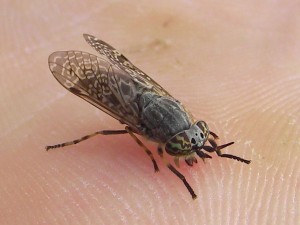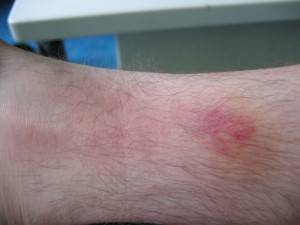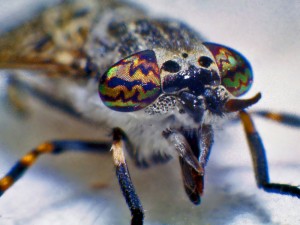Occurrence: Rainbells are mainly found in areas with water where there is moist soil, such as marshland. In Denmark, they only occur during the summer months. They are especially common during the daytime on warm and humid days.
FoodThe adults feed on plant nectar, while the larvae are predators that feed on small organisms and can even be cannibalistic. The adult female cuckoo bites humans to suck blood, which they need to develop eggs.
Combat: It is difficult to control cleavers because there are no means that are specifically suitable for this purpose. Scientists sometimes use special glue traps filled with animal urine, but this is not a real solution for private individuals. The best advice is to use specific mosquito repellents (see below) if you are in an area with a lot of rainbugs.
Avoid rainfly bites
The only way to avoid rainfly bites is to use the most effective mosquito repellents on the market. Although mosquito repellents are more effective against mosquitoes than hatchlings, they still have some effect on hatchlings.
We recommend these remedies against rain clover:
These products are recommended to keep rainbugs at bay
About the bite of rainbugs
Like all other cleavers, rain clovers are most active when the sun is out and there is sufficient humidity. The risk of rainfly bites decreases the cooler and darker it is and they always avoid shady places. At night they are inactive.
In Scotland, where the problem with cleavers and a few other stinging insects is high, they say "when the sun is out, the clegs bite; when the sun goes in the midges bite", which translates to "When the sun is up, the claws bite; when the sun goes down, the midges bite“.
Although the problem with cleavers and mites is generally not that big in Denmark, you can be unlucky and get attacked by cleavers and mites on the same day. Read more about mites here.
The bite itself
Rainbugs, like their fellow species, have sharp mouthparts that they use to cut into the skin of the hosts they are sucking blood from. The bite itself is painful because the mouthparts create a triangular wound in the skin, which - unlike a mosquito bite, for example - is much more open.
Although the earthworm does not inject venom (like bees or wasps), its saliva contains some anticoagulant substances that keep the blood flowing. These substances can cause further irritation and swelling at the bite site.
The normal symptoms are pain, redness and swelling around the bite site. Rainfly bites are usually described as being more painful than bites from mosquitoes, wasps and bees, for example - but symptoms can vary from person to person.
In some cases, symptoms can be more severe, which is likely due to a systemic reaction in the body. In very rare cases, full-blown allergic reactions with severe symptoms are seen. For an allergic reaction to occur, one must be genetically predisposed to it. Deaths due to anaphylactic shock is observed in extremely rare cases.
The claws are relatively easy to hit when you slap them with your hand, but they are often hardy and do not necessarily die on the first slap. They don't usually flee when you hit them. In other words, they tend to "stick" to their hosts.
When hatchlings fly around the host, they don't disappear even if you strike out at them. This has earned them the nicknames blind flies and blind brakes despite the fact that brakes are different insects. In places where there are a lot of cleavers, you can risk being attacked by several at the same time.
Treatment of rainfly bites
Although racoon bites can't be treated as effectively as, for example mosquito bitesIf you have a bee or wasp sting, you can use some of the same care products to relieve the symptoms of an itch bite.
We recommend the two tools shown below:
We recommend these remedies for treating rainfly bites
In more serious cases - for example, where there is more swelling and fluid draining from the bite site - you should see a doctor.
Other tips for treating rainfly bites include:
- Relief: Immediately after being bitten, you should apply one of the soothing remedies listed above - if you don't have one on hand, you can apply a little saliva.
- Cleaning: Clean the wound as soon as possible with clean water and soap. You should clean the wound regularly in the following days (until it heals).
- ItchingAvoid scratching the wound as this increases the risk of infection. The remedies above will reduce itching.
If the wound worsens or shows signs of infection, you should seek medical attention.
Description of the rain hatch
Rainbows are usually between 8 and 10 mm long, but females can grow up to 12 mm in length.
The wings are slightly transparent with patterns and light brown spots. The legs are black with yellow-brown rings.
The eyes are large and have a vivid play of colors. These colors disappear when the hatchling dies (this applies not only to rainbows, but also to many of their fellow species).
Rainbow jays have very well-developed eyesight and are used to find prey, among other things.
The chest is gray with stripes across it. The abdominal area is divided into bands that are dark in color and covered with light spots.
Distribution and prevalence
Rainbells are found in almost all of Europe, Southwest and East Asia.
In Denmark, they are only active during the summer months and are especially common on hot, humid summer days. They generally thrive in areas with water, such as coastal marshes.
Eggs and larvae
Rainbugs lay their eggs at grass roots on moist (but not wet) soil. They can also thrive in silt and other environments with the right humidity.
The caterpillars of the rainfly thrive best on moist soil that has not been plowed or fertilized. The larvae feed on small organisms that live in the moist soil. They can exhibit cannibalistic behavior.
Females and males
As with all other blood-sucking insects, only the female rainfly sucks blood. This is necessary in order to develop eggs.
Male rainbows are rarely seen. This phenomenon is of course due to the fact that only the females sting and therefore have the most contact with humans. However, it's remarkable that male rainbows are hard to find - even if you actively look for them. When you do find a male, it's usually only one or a few (less than ten).
Males are mainly found in tall grass in relatively open areas close to water. They usually perch at the top of the grass or under leaf tips and fly short trips around the grass.
Name and classification
Rainbows are a species (Haematopota pluvialis) in a genus (Haematopota), which belongs to the Klæger family (Tabanidae). The family is part of the order Tovinger (Diptera), which includes flies, among other things, mosquitoes and center.
The genus name of the rainbow chick Haematopota derives from the ancient Greek words haima and pótëswhich means "blood drinker". The word pluvial means "the rains", so its name Haematopota pluvialis best translates to "the blood drinker of rain".



